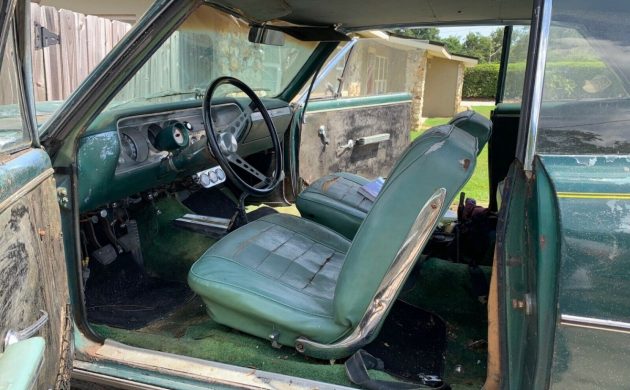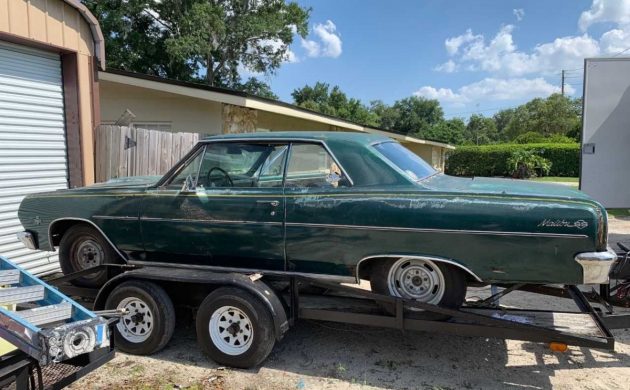While some cars have very little going for them, and others seem to be a steal of a deal, this one sits in the middle. This 1965 Chevrolet Malibu SS is not a numbers matching car, but it is somewhat solid after spending its life in Oklahoma. It currently resides in Apopka, Florida, and is stated to have a true SS 138 VIN. You can find it here on eBay with a current bid price of $6,500 and the seller has the title in hand.
No mention of the 327 cubic inch V8 engine being brought to life is mentioned. The engine is connected to a center console-mounted four-speed manual transmission. It has a 4-bolt main with a 12-bolt rear end. It also has an aluminum radiator. They do note as well that the trunk pan needs to be replaced, along with the rear passenger quarter panel, and one trunk hinge. The undercarriage photo shows a surprisingly solid car.
What little can be gathered from the two interior photos is that it is not half bad. The listing does say that the tachometer is on the dashboard. Not much else is mentioned. All the seats seem to still be in excellent condition. After a little bit of cleaning, you will have the interior in a very comfortable state quite quickly. The rear decklid does appear to be cracking, which is understandable given this car looks like it has been basking in the sun for a long time.
In a somewhat surprising offer, the seller notes that the hauler can be purchased as well, for an additional $1,500. At that point, all you need is a vehicle to tow the whole lot with, and you are good to go. This Goldilocks of a Malibu does need some work to be truly restored, but it might not need much to get it roadworthy. Depending on the final bid price, you could have yourself the car and trailer and a great rest of the summer project car.








A definite yes from me.
Good news: an example of The second best Chevelle SS is for sale, the first being a ‘64!
More good news-he’s got the title!!! Now there’s a change for a car starting at a reasonable price..
The bad news-unless it stays under $10K, it’s going to be someone with a serious lust for this model to make it a worthwhile project.
But then again isn’t this why we buy cars like these that need complete interior makeovers inside and lots of work on the outside?
Some other questions though; why mount another tach on the steering column and more gauges under the dash if the gauge cluster and factory optioned tach are in the dash? Would it be possible to see more interior photos, preferably without the dirty laundry and jack on the floor so we can really see the inside? Does the motor move freely? It’s “not a numbers matching car”. What component(s) don’t match?
I’d love to find an affordable project Chevelle like this one may become for the right price but it’s on The Wrong Coast..dang!
Nevada,
The tach question is easy: It costs about 1/4 as much to run down to Pep Boys and buy a cheap no name tach and hose clamp as it does to send the factory unit to a specialist for mending. The rest of your questions will have to remain a timeless mystery, you see this kind of ad constantly. So strange.
I like it. It has all the goodies I want.
Paint problems look mainly like failing clearcoat. I’m wondering if it is possible to carefully remove the clearcoat, hopefully revealing a good base coat?
Yes, there are quite a few videos showing how to remove clear coat by wet sanding. Requires a lot of patience.
Unless it has already been repainted the 65 chevelle did not come from the factory with a clear coat finish. Strip to bare metal and repaint or leave it ugly patina
I’m often taken aback when I see people change or attempt to change the factory color of a car. When new, this was such an attractive color combination. Originally a very dark blue exterior (E-E = Danube blue metallic) with a lighter blue (741 = Medium blue imitation leather) interior. Who knows what they were thinking doing this.
On the plus side, it is a factory SS, V8, bucket seat, 4 speed car.
The 65 SS did not come with side trim. However, this could have been added after the fact. This chevelle has a lot of rust on both quarters and top of the rocker panels. I would pass on this one.
Seats in excellent condition? Them covers are are toast
There’s a claimed to be real Z16 Chevelle elsewhere on this site today and then there is this ’65 SS that a consumer could actually go out and buy brand new. Just a hard driven street machine is what I’m looking at here, which ain’t half bad.
I like it but I would still pull the motor and put the 396 in it I have on my engine stand in my shop!! SS or not i would have to put that BB in it!!!
Hmm were four bolt mains ever available on a 327?
Steve, as I’m reading this write-up, followed by various comments about whether this car is worth the investment, you ask the exact question I’ve been wanting to comment on: “were four bolt mains ever available on a 327?” Truth is, no there were not, in fact, there were no 4-bolt main small blocks ever with Chevrolet’s 1st generation of small journal crankshaft V-8’s. This family of small block’s included the 265, 283, and 327 up to & including the 1967 (all) model year. 1967 also was the 1st year for Camaro which was available with a 1-year only 302 small journal crank. The obvious reason none were ever factory produced was that the interior webbing (casting) of the small journal V-8 lacked enough structural support required to handle the additional holes that a 4-bolt main block has. Beginning in 1968 Chevy introduced the large journal small blocks, permanently replacing the small journal platform. In 1968 & 1969 only, the 327 was still available, but now was a large journal design, but never “factory” produced with 4-bolt mains. If anyone ever wants to build their very own 302 small block it’s easily done with a small journal 327 spinning a 283 crank & rods. And we all thought the engine designers GM had at the time were genius’s. Enough on the “fake” 4-bolt main 327, there is another problem with this shade of green, besides it having clear coat issues (fyi, there were no 2-stage painted cars coming out of Detroit in 1965, just simple acrylic 1-stage colors), the E-E trim code, as JW454 points out, indicates a color change both inside & out. So here we have a “fake” 327 with a non-original color change 1965 SS Chevelle. Between this one & the “fake” Z16 also written up earlier, I can’t figure out which one is the “fakest” At least the “Z16” has the correct clock mounted on top of the dash, which was the ‘standard’ if it had a factory tach dash. I don’t claim to be the know-it-all with the 1965 model year, but I do still have my 1st car that I purchased at the age of 17 & it’s a 1965 Malibu Conv. Within a year after that I went on to purchase, drive, and sell 11 more 1965’s.
Ok, curber or not, this is the best buy of 2019 on the site. Even needing trunk work and possibly panel work for the hinges this car has serious potential. Would have liked to see pix of the floor pan but can’t have everything……and as usual it’s location might as well be on Bikini Atoll for those of us on the left coast…sigh..
Lot of work and money required.
Find one closer to finished
I always believed the 365 H.P. 327 was a 4 bolt main. Plus the small journal 327 was supposed to be around 63 64 something like THAT. I was just on line and some people claim that in 1967 68 327s did come with 4bolt mains as Chevy blocks were standardized. I had also heard some 283 blocks could be bored .120 over. (must sonic check for core shift) don’t know for sure. Anyone want to chime in?
Don’t believe everything you read on the internet. Gary is correct, no four bolt 327 engines. Lot of things about this car to like but it will require a full restoration. Hope the new owner is up for that.
The 327 was released 1st in 1962, it was the whole reason my father bought the Corvette that year. SC/RAMBLER, I never said that the 68-69 327 couldn’t be machine to accept 4-bolt mains, I only said the factory did not do it, & in 1967 the 327 was still small journal. Here’s the easy way to remember, once production of the 283 ceased, large journal began, along with spin-on oil filters – no more cartridge filters on the small blocks. 1968 was also the 1st year for the 307 which replaced the 283 as the bread & butter small block. You mention that you heard of 283’s having over-bore’s of .120, you are 100% correct. Specifically the blocks produced for trucks & from the GM foundry in Mexico. Do some historical research on the Mother Nature 57 Chevy Wagon that, in it’s day was running 10’s all day long with “only” a 283. That retired car & it’s driver are in a shop just a block up the street from me. That wagon achieved those numbers using the thicker casted 283’s punched out up to .120 over, backed by a torque converter out of the early Vega’s, which were excellent & cheap for use as a high stall speed converter when bolted up to a V-8.
Thanks for clearing that up for me. Years ago when the 396 in my 67 Chevelle SS was in need of rebuilding someone tried to trade a supposed 4bolt main 365 H.P 327 for the 396. I didn’t go for it and shortly thereafter I got hit by a drunk driver end of Chevelle.
i
Interesting that there are 84 watchers, with a day left on the auction, and not a single bid yet. I wonder how the Z16 sale is going; both of which, in their own right, are way over priced.
22 minutes left. No bids.
And…it’s a no sale.
The 327 has a geometry that makes it easy to beef up & spin @ higher R.P.M.s… I’ve built several & always use main studs & billet main caps along with a line bore & balancing. My personal favorite, the 327 with a stick trans behind it is great combination for a fun time! Add some newer suspension components to make it low slung & this era Chevelle is a riot to drive!